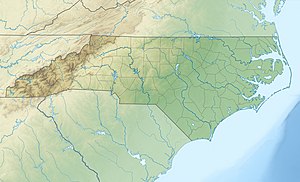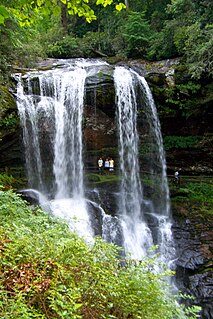| Rough Butt Creek Tributary to Caney Fork | |
|---|---|
| Location | |
| Country | United States |
| State | North Carolina |
| County | Jackson |
| Physical characteristics | |
| Source | divide between Rough Butt Creek and Wolf Creek |
| ⁃ location | about 0.5 miles southwest of Rough Butt Bald |
| ⁃ coordinates | 35°18′42″N082°58′27″W / 35.31167°N 82.97417°W [1] |
| ⁃ elevation | 4,900 ft (1,500 m) [2] |
| Mouth | Caney Fork |
⁃ location | about 2 miles east-northeast of Rich Mountain, North Carolina |
⁃ coordinates | 35°19′29″N082°01′36″W / 35.32472°N 82.02667°W Coordinates: 35°19′29″N082°01′36″W / 35.32472°N 82.02667°W [1] |
⁃ elevation | 2,930 ft (890 m) [2] |
| Length | 3.31 mi (5.33 km) [3] |
| Basin size | 3.51 square miles (9.1 km2) [4] |
| Discharge | |
| ⁃ location | Caney Fork |
| ⁃ average | 11.89 cu ft/s (0.337 m3/s) at mouth with Caney Fork [4] |
| Basin features | |
| Progression | west-northwest |
| River system | Tuckasegee |
| Tributaries | |
| ⁃ left | unnamed tributaries |
| ⁃ right | unnamed tributaries |
Rough Butt Creek is a stream in Jackson County, North Carolina, in the United States. [5] It is located within the Nantahala National Forest.

Jackson County is a county located in the southwest of the U.S. state of North Carolina. As of the 2010 census, the population was 40,271. Since 1913 its county seat has been Sylva, replacing Webster.

The United States of America (USA), commonly known as the United States or America, is a country comprising 50 states, a federal district, five major self-governing territories, and various possessions. At 3.8 million square miles, the United States is the world's third or fourth largest country by total area and is slightly smaller than the entire continent of Europe. With a population of over 327 million people, the U.S. is the third most populous country. The capital is Washington, D.C., and the most populous city is New York City. Most of the country is located contiguously in North America between Canada and Mexico.

The Nantahala National Forest, established in 1920, is a national forest located in the American state of North Carolina. The word "Nantahala" is a Cherokee word meaning "Land of the Noonday Sun." The name is appropriate as, in some spots, the sun only reaches the floors of the deep gorges of the forest when high overhead at midday. The Spanish Conquistador Hernando de Soto explored the area in 1540, as did William Bartram in the 18th century. The Nantahala River flows through the Nantahala National Forest.
A hiking trail along Rough Butt Creek leads to a 35-foot (11 m) waterfall. [6]

A waterfall is an area where water flows over a vertical drop or a series of steep drops in the course of a stream or river. Waterfalls also occur where meltwater drops over the edge of a tabular iceberg or ice shelf.




